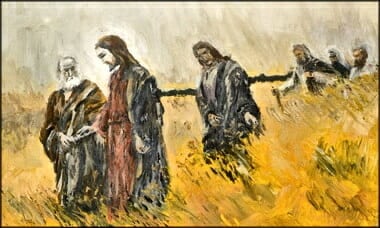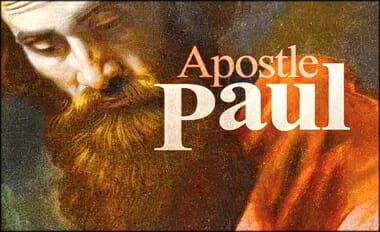- Craig S. Keener, Acts: An Exegetical Commentary & 2: Introduction and 1:1–14:28, vol. 1 (Grand Rapids, MI: Baker Academic, 2012–2013), 1622–1626.
(4) Letters of Authorization (9:2)
Letters from Jerusalem to the Diaspora are attested over a long period.231 Official letters from a person in an office to others also in office were often posted in public locations, which made them a readily recognizable letter form.232 Here, however, the letters are letters of recommendation that Paul carries.
Those who carried letters from a high official acted on that official’s authorization (1 Esd 4:61; Neh 2:7, 9). Letters of recommendation of various sorts reflect a pervasive custom (Rom 16:1–2; 1 Cor 16:15–18; Phil 2:29–30; 4:2–3; 1 Thess 5:12–13; Phlm 8–17; Heb 13:17; 3 John 12);233 thus, for example, leaders in Jerusalem sent letters confirming Josephus in his authority (Jos. Life 310–11).234 Sometimes people of rank sent such letters for their clients or others to provide them “credentials for some activity rather than merely to introduce” them.235 In general, travelers could carry letters of recommendation so that the receiver would know to welcome them.236
Some comments about the context of recommendation letters can illustrate their general function, although many of the specific elements mentioned here (perhaps especially in formal Roman letters) would not appear in the high priest’s letters for Paul. Recommenders placed their own credibility on the line when writing such letters,237 but they socially indebted to themselves those so recommended.238 Appeal to the potential benefactor’s generosity was a natural element in many recommendation letters.239 Further, when two people shared a mutual friend, they became friends, part of the same in-group.240 The receiver of the recommendation would act on the basis of the receiver’s relationship with the recommender, and hence recommendations might spell out the beneficiary’s relationship with the recommender.241 By generosity to the beneficiary, the benefactor displayed friendship with the recommender242 and also guarded the recommender’s honor in the eyes of the beneficiary.243 When the letter’s receiver was of the same (rather than lower) social station as the recommender, the receiver might express or anticipate reciprocity for the favor done.244
Despite conventional forms, writers could prove creative in articulating reasons for receiving the recommendations.245 Powerful writers sometimes claimed that the person on whose behalf they wrote was more deserving than any other (cf. Phil 2:20) or that this beneficiary was a particularly special one—even when they had written many other such letters with superlative claims.246 They could also request that the beneficiary be treated as if the beneficiary were in fact the recommender.247 Or they could simply request that the letter recipient receive well its bearer.248 Sometimes, at least in later times, they might assert that the receiver already knew the worth of the one recommended, or that no letter was really necessary.249
Among Romans of rank, such letters were often only one250 to four paragraphs in length. At least in Egypt, the usual structure of letters of recommendation was as follows:251
- Opening
- Salutation formula
- Formula valetudinis
- Background
- Identification formula
- Background proper
- Request period
- Request clause
- Circumstantial clause
- Purpose or causal clause
- Appreciation
- Closing
- Closing formula valetudinis
- Closing salutation
The letters usually began by identifying the person recommended and designating the person’s relationship to the sender;252 for Saul, then, it would be a great honor to carry such a letter (cf. Gal 1:1, 14). Later, as an apostle “not from men” but from Christ (1:1), Paul would eschew dependence on such letters of recommendation (2 Cor 3:1–3). (Even when Paul writes recommendations in his letters, the basis differs from that in most other letters of recommendation.)254
(5) Extradition Requests Here? (9:2)
People of higher rank expected subordinates to obey their letters (e.g., 1 Kgs 21:8; Esth 1:22; 8:10; 9:20, 30; 1 Macc 1:44). But is obedience demanded here? Some scholars have argued that the high priest had extradition rights for Judean fugitives that would be respected by rulers in the region.255 This may have been true in the second century b.c.e. if we may trust our sources on this point; the Romans granted Judea extradition rights from Egypt’s ruler (1 Macc 15:21),256 [see] and Julius Caesar presumably reconfirmed these rights in 47 b.c.e. by making the high-priestly family ethnarchs over all Jews and arbiters of Jewish customs (Jos. Ant. 14.189–95). Rome also granted King Herod extraordinary rights for extraditing fugitives from the region of his jurisdiction (War 1.474, acknowledging this situation as unusual).257 [see]
In this period, however, Judea had a Roman governor.258 [see] Even if Pilate in Caesarea remained aloof from the Jerusalem aristocracy’s affairs, other governors were under no legal or political obligation to another city’s aristocracy. The letters, however, are not to local governments but, as Luke expressly claims, to synagogues (Acts 9:2).259 [see] Local Jewish communities retained rights to practice their own customs as ethnic conclaves in foreign cities;260 [see] consequently, they would be able to continue practicing disciplines in their own synagogues (Luke 21:12; Matt 10:17; 2 Cor 11:24) so long as no one renounced Judaism and complained of subsequent abuse.261 [see] Just as Alexandrian Jews had an ethnarch and Nabateans in Damascus had an ethnarch (2 Cor 11:32), Damascene Jews would possess a measure of autonomy. Most synagogue leaders would have acted out of respect for the high priest.262 [see] If conflicts arose, local municipal authorities probably would have (though need not have) chosen to defer to the rights of minority communities in disciplining their own members.263 [see] In this case, they may have secured the cooperation of other groups as well (2 Cor 11:32).
But at minimum, the letters could encourage support less forcefully, simply commending Paul (see discussion of recommendation letters, above) and authorizing his mission in more basic ways. Saul and his companions would not have the advantages of travel given to those traveling on Rome’s business,264 [see] but letters of recommendation from the high priest would guarantee them aid along the way from local Jewish communities. The objects of Saul’s quest would not be local Jewish Christians (he and his allies may well have hoped there were none) but fugitives from Jerusalem, where the high priest exercised direct civic authority.265 [see]
Synagogues appear often in Luke-Acts, but the reference to their involvement in persecution here (cf. Acts 22:19; 26:11) partly fulfills the warning of Luke 21:12: soon after Jesus’s ministry but before predicted wars and earthquakes (21:10–12), his followers would be handed over to synagogues for discipline. “Binding” free people was a terrible insult to their dignity (Polyb. 1.69.5; see comment on Acts 21:33–34). That women were also targets indicates the vicious lengths to which Saul went to eradicate the movement (cf. Val. Max. 9.2.1); see comment on Acts 8:3.
231. Bauckham, “James,” 423–24, cites the Elephantine papyri (fifth century b.c.e.) and 2 Macc 1:1–10.
232. Aune, Environment, 164–65.
233. E.g., Cic. Fam. 7.5.2–3 (with 7.6.1; 7.7.1; 7.8.1; 7.10.3); 13.1–79 (all of Fam. 13 except 13.68); Socratics Ep. 28; cf. Men. Rhet. 2.5, 397.21–24; see esp. Kim, Letter of Recommendation, passim (for nt examples, 119–20; for papyri, 150–238); also Agosto, “Conventions,” 70–117; Keyes, “Letter of Introduction”; Marshall, Enmity, 91–129, 268–71; more briefly, Stowers, Letter Writing, 153–65; Aune, Environment, 166–67; Malherbe, Social Aspects, 102; Keener, Corinthians, 166–67.
234. For a later rabbinic example, see, e.g., y. Moʾed Qaṭ. 3:1, §2.
235. Stowers, Letter Writing, 153. Writers normally interceded for the third party to establish his positive relationship with the receivers or secure him some other favor with them (ibid., 155); they also often identify the sender with the one recommended (Malherbe, Social Aspects, 102–3, citing P.Oslo 55).
236. E.g., Lucian Lucius 2.
237. E.g., Pliny Ep. 2.9.2. Although writing many letters, Cicero assures his receiver that he is sensitive to his reputation and thus does not recommend indiscriminately (Fam. 13.48.1). Thus some letters are worded more cautiously (e.g., Symm. Ep. 1.72).
238. E.g., Pliny Ep. 2.13.9; 3.2.6; 3.8.2.
239. E.g., Cic. Fam. 13.44.1; Pliny Ep. 10.4.1; 10.94.3; 10.120.2; Phlm 14.
240. Malina, Windows, 48.
241. E.g., P.Oxy. 292; Cic. Fam. 13.3.1; 13.5.3; 13.44.1; Dio Chrys. Ep. 2; Pliny Ep. 2.13.7, 10; 3.2.4; 7.16.5; 10.4.1, 4; 10.5.1; 10.11.1; 10.87.1; 10.94.1; Fronto Ad Ant. Pium 9.2. For the papyri, see further Kim, Letter of Recommendation, 37–42. Cf. the recommendee’s readiness to depend on the recommender’s relationship with the receiver of the letter (e.g., Symm. Ep. 1.70; 1.81; 1.106; 1.107).
242. So explicitly in Pliny Ep. 10.4.6; see also Symm. Ep. 1.30; 1.71. In some parts of the world today, such social demands lead to considerable corruption; this was true in Rome as well, but ethical constraints did impose some limitations.
243. E.g., Cic. Fam. 1.3.2. Cicero’s letters of recommendation often ask the benefactor to prove to the recommended person how good a recommendation Cicero had written on the recommended one’s behalf and how influential Cicero had been for good (e.g., Cic. Fam. 13.19.3; 13.20.1; 13.26.4; 13.30.2; 13.35.2; 13.36.2; 13.44.1; 13.45.1; 13.46.1; 13.49.1; 13.58.1; 13.77.2; 13.78.2); cf. also Symm. Ep 1.93; 1.106. For correspondents proving their love, cf., e.g., Symm. 1.14.1; 1.27; 1.43.2; 1.87; 1.98; 2 Cor 8:24.
244. E.g., Pliny Ep. 2.13.1–2; 3.2.1; 4.4.2–3; 7.31.7. If the letter receiver’s status was less, the receiver would respond especially with gratitude (Fronto Ad Ant. Pium 9.1). Gratitude was critical, both for the recommender and for the beneficiary (e.g., Cic. Fam. 13.3.1; Pliny Ep. 4.12.1, 5–7).
245. E.g., Pliny Ep. 3.3.5; 6.8.1–2, 5. Articulating reasons was essential (Dio Chrys. Ep. 1; esp. Pliny Ep. 2.13.11).
246. E.g., Cic. Fam. 3.1.3; 13.1.5; 13.5.3; 13.18.2; 13.19.1; 13.26.1; 13.32.2; 13.34.1; 13.35.1; 13.36.1–2; 13.39.1; 13.45.1; 13.51.1; 13.78.2.
247. E.g., P.Oxy. 32; Cic. Fam. 13.5.3; cf. 1 Cor 16:10; Phlm 17; Kim, Letters of Recommendation, 7, 37–42.
248. See, e.g., P.Grenf. 2.77.34–38 (from the third or fourth century c.e.). Officials could also use public recommendations to commend their friends (e.g., P.Lond. 1912.105–8).
249. E.g., Symm. Ep. 1.22; 1.67; 1.75; 1.81. In Ep. 1.63, Symmachus claims that he recommends one for the letter receiver’s benefit; in Ep. 1.94, he hopes his letter adequate to communicate the recommendee’s merits; in Ep. 1.104, the recommendee is better than the letter is able to convey.
250. For one paragraph, see, e.g., Cic. Fam. 13.45–49.
251. Kim, Letter of Recommendation, 7 (mostly using his words). Paul’s letters do not share this form (128), but most Christian letters of recommendation from Egypt do (99–118); for the eighty-three letters that Kim analyzed, see 156–238.
252. Ibid., 37–42.
253. Paul does send his own recommendations, usually embedded in larger letters; see ibid., 120; Agosto, “Paul and Commendation,” esp. 110–28. But like some philosophers (Diogenes Ep. 9; Epict. Diatr. 1.9.27, 33–34; 2.3.1–2; cf. 4.12.12), he did not want to depend on them for himself.
254. See esp. Agosto, “Paul and Commendation,” 127: Paul commends especially on the basis of work in the church rather than of social connections. But even with Paul, such connections remain; e.g., Rom 16:2; Phil 2:22, 30; Phlm 10–13.
255. E.g., Reicke, Era, 149; Bruce, Apostle, 72.
256. Bruce, Apostle, 72, noting that the author Lucius (1 Macc 15:16) is presumably Lucius Caecilius Metellus, consul in 142 b.c.e. Not all accept as certain the document’s authenticity (Wallace and Williams, Acts, 52, who favor unofficial action here).
257. Bruce, Apostle, 72; idem, Commentary, 193; Johnson, Acts, 162 (providing the information but not committed to the conclusion). Cities normally agreed to extraditions only if they were on good terms (Livy 41.23.1–5; Dio Chrys. Or. 38.41–42).
258. Some argue that Damascus may not have even been under direct Roman rule in this period (see Barrett, Acts, 446); for further discussion, see excursus on Nabateans at Acts 9:23.
259. With Barrett, Acts, 446. Haenchen, Acts, 320–21n3, has therefore misread Acts (in averring that Luke read the Maccabean situation into it) no less than its attempted defenders above. For influential festal letters uniting Jewish communities, see Whitters, “Observations” (citing Esth 9:20–32; 2 Macc 1:1–9; 1:10–2:18; Elephantine’s “Passover Papyrus”; and later 2 Bar. 78–87); for some early encyclical letters from sages, see Aune, Environment, 185.
260. E.g., Jos. Ant. 14.213–16, 223, 227, 242, 245–46, 258, 260, 263; 16.162–65; see discussion in Sanders, Judaism, 212; Rabello, “Condition”; Rajak, “Charter.”
261. For a discussion of proper scourgings as outlined in m. Mak. 3, cf. Gallas, “Fünfmal.”
262. Many scholars doubt that the high priest exercised authority over other Diaspora Jews; others argue the contrary (Bruce, Commentary, 193) or against doubting Luke without firm evidence (Munck, Acts, 81). I doubt that the high priest had in the Diaspora any legal authority recognized by the empire; nevertheless, the effectiveness of the temple tax (Jos. Ant. 18.312) and the biblical and Maccabean roles for the high priesthood indicate the respect and influence that he commanded (rightly, Dunn, Acts, 120–21; Witherington, Acts, 316; Haenchen, Acts, 71). Nevertheless, later rabbinic arguments about the Sanhedrin’s Diaspora influence (m. Mak. 1:10, cited in Rapske, Custody, 101; t. ʿOr. 1:8; Sanh. 3:10; Sipre Deut. 59.1.2; 188.1.2; perhaps y. B. Qam. 4:1, §3; Giṭ. 5:6, §3; cf. negative relations in t. ʿAbod. Zar. 4:6) are uncertain for their own period and certainly cannot be retrojected into Paul’s (see Keener, John, 212–13). And even later rabbis allowed courts outside the land (t. Sanh. 3:10).
263. This may have been especially the case if Damascus’s minority communities had influential ethnarchs, as at least the Nabateans seem to have had; see comment on Acts 9:23–24. Cf. Campbell, Deliverance, 147: “With the permission of the local authorities, the Jerusalem authorities could have claimed jurisdiction over Jews in other regions.… Moreover, the ‘letters’ in question may have been ‘requests’ rather than ‘orders’ and Luke a little hyperbolic at this point.”
264. On which see Casson, Travel, 188; cf. 197. Paul’s companions could have been Levite police delegated to him (e.g., Lenski, Acts, 357) but may have simply been other young and zealous members of the Hellenist synagogue (6:9) who shared his commitments.
265. With, e.g., Lake and Cadbury, Commentary, 100. It is possible that these events occur before the Samaritan and Gentile conversions in Acts 8 and hence too early for many local conversions to have occurred; otherwise, they may occur only shortly later.
























